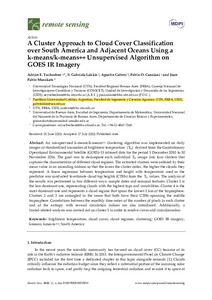Por favor, use este identificador para citar o enlazar este ítem:
https://repositorio.uca.edu.ar/handle/123456789/11512| Título: | A cluster approach to cloud cover classification over south america and adjacent oceans using a k-means/k-means++ unsupervised algorithm on goes ir imagery | Autor: | Yuchechen, Adrian E. Lakkis, Susan Gabriela Caferri, Agustin Canziani, Pablo O. Muszkats, Juan Pablo |
Palabras clave: | NUBES CIRRUS; TEMPERATURA; GEODESIA; INSTRUMENTOS DE MEDICION; ALTIMETRIA | Fecha de publicación: | 2020 | Editorial: | Molecular Diversity Preservation International | Cita: | Yuchechen, A. E., Lakkis, S. G., Caferri, A., Canziani, P. O., Muszkats, J. P. A cluster approach to cloud cover classification over south america and adjacent oceans using a k-means/k-means++ unsupervised algorithm on goes ir imagery [en línea]. Remote Sensing. 2020, 12. Disponible en: https://repositorio.uca.edu.ar/handle/123456789/11512 | Resumen: | Abstract: An unsupervised k-means/k-means++ clustering algorithm was implemented on daily images of standardized anomalies of brightness temperature (Tb) derived from the Geostationary Operational Environmental Satellite (GOES)-13 infrared data for the period 1 December 2010 to 30 November 2016. The goal was to decompose each individual Tb image into four clusters that captures the characteristics of different cloud regimes. The extracted clusters were ordered by their mean value in an ascending fashion so that the lower the cluster order, the higher the clouds they represent. A linear regression between temperature and height with temperature used as the predictor was conducted to estimate cloud top heights (CTHs) from the Tb values. The analysis of the results was performed in two different ways: sample dates and seasonal features. Cluster 1 is the less dominant one, representing clouds with the highest tops and variabilities. Cluster 4 is the most dominant one and represents a cloud regime that spans the lowest 2 km of the troposphere. Clusters 2 and 3 are entangled in the sense that both have their CTHs spanning the middle troposphere. Correlations between the monthly time series of the number of pixels in each cluster and of the entropy with several circulation indices are also introduced. Additionally, a fractal-related analysis was carried out on cluster 1 in order to resolve cirrus and cumulonimbus. | URI: | https://repositorio.uca.edu.ar/handle/123456789/11512 | ISSN: | 2072-4292 | Disciplina: | INGENIERIA AMBIENTAL | Derechos: | Acceso abierto | Fuente: | Remote Sensing. 2020, 12. |
| Aparece en las colecciones: | Artículos |
Ficheros en este ítem:
| Fichero | Descripción | Tamaño | Formato | |
|---|---|---|---|---|
| cluster-approach-cloud-cover.pdf | 3,02 MB | Adobe PDF |  Visualizar/Abrir |
Visualizaciones de página(s)
85
comprobado en 27-abr-2024
Descarga(s)
110
comprobado en 27-abr-2024
Google ScholarTM
Ver en Google Scholar
Este ítem está sujeto a una Licencia Creative Commons

